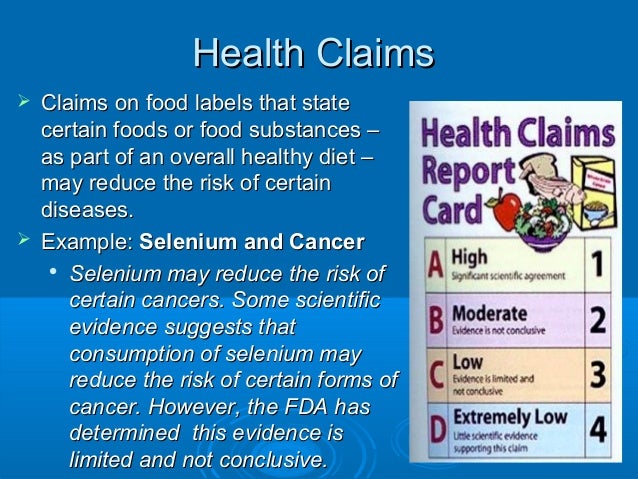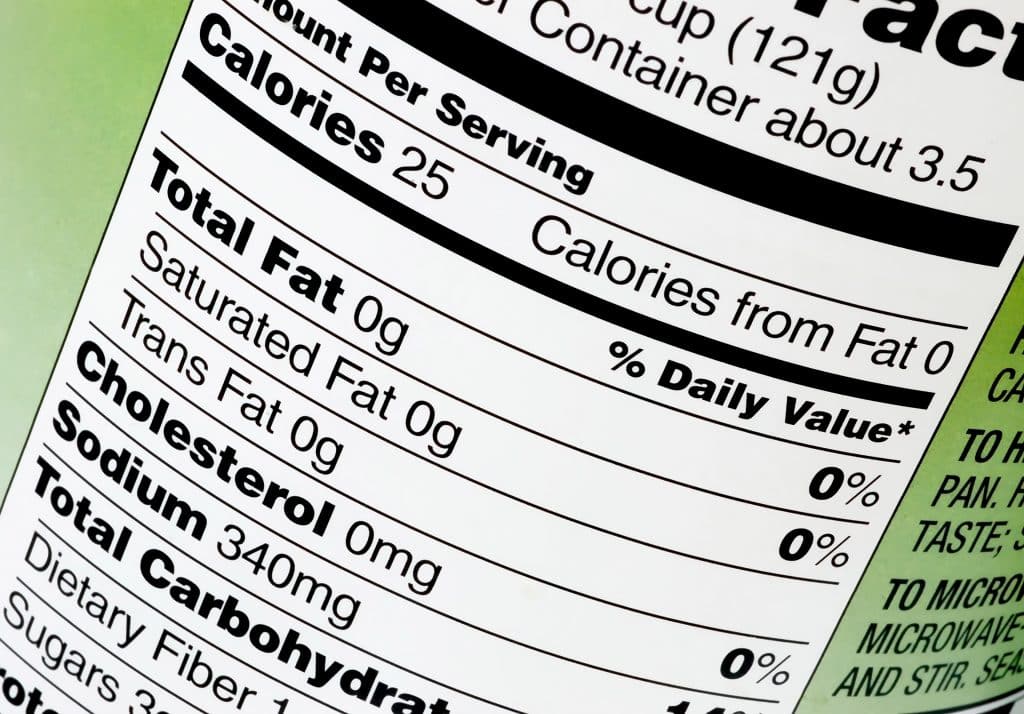40 what are nutrient claims on food labels
Food Label Claims: What You Can and Can't Trust - WebMD Nutrients. These affect your health the most. You'll want to get less saturated fat, sodium, and added sugars and more fiber, vitamin D, calcium, iron, and potassium. Calories. This number is per... Nutrient Claims on Food Labels - Clemson's HGIC What is a Nutrient Claim? This is a claim concerning a product's nutritional value. It describes the content of a food, including the amount of nutrients, calories, cholesterol, or fiber, but not in exact amounts. Usually placed on the front of the food label, the nutrient claim provides a quick comparison between similar products.
Food Label Nutrient Claims: Is It Really Good for You or Just a Gimmick ... Nutrient claims on food packages boasting of added health benefits are meant to grab the customer's attention. This is basically a marketing scheme to get consumers to buy more of a company's products. However, beware of false or misleading claims. For example, foods CANNOT say, "WILL reduce the risk of heart disease."

What are nutrient claims on food labels
List of Nutrition Labels | Nutrition Claims Certification Saturated Fat Free. This label provides proves that your product has been independently verified and tested as Saturated Fat Free by a third-party certifier. Saturated Fat Free Nutrition Label is eligible if the sum of saturated fatty acids and trans-fatty acids in the product does not exceed 0.1 g per 100 g or 100 ml. PDF Nutrient Label Claims - Veterans Affairs Nutrition Handouts • N23 Version 5.0 Page 1 of 4 Nutrient Label Claims The claims on food labels can be confusing. Knowing what these claims mean can help you choose healthier products. Sugar Claims What does this mean? Sugar Free, Zero Sugar, No Sugar, Without Sugar, Negligible Source of Sugar, Trivial Source of Sugar, Dietarily PDF Declaring Voluntary Nutrients on Your Nutrition Facts Label •Claims •If claims are made about a nutrient, then that nutrient and in some cases, related nutrients must be declared "Cholesterol Free" Mono and Polyunsaturated Fats might be required "Sugar Free" Sugar Alcohol might be required "High in Antioxidants…" list the specific vitamin(s) Know the Claims conditions and
What are nutrient claims on food labels. Nutrient Claims Reference Chart - Helping You Choose Healthy Foods Less than 0.5 grams of fat per serving. Low fat. 3 grams or less of total fat. Low saturated fat. 1 gram or less saturated fat per serving. Saturated fat free. Less than 0.5 g of saturated fat. perserving and the amount of. trans fatty acids does not exceed 1% of the total fat. Nutrient Claims on Food Labels - Truly Good Foods Nutrient claims describe the content of a food, including the amount of nutrients, calories, cholesterol or fiber, but not in exact amounts. Usually on the front of the food label, the nutrient claim provides a quick comparison between similar products. Ever wondered about the validity of nutrient claims? Food labelling for industry - Canadian Food Inspection Agency The Industry Labelling Tool is the food labelling reference for all food inspectors and stakeholders in Canada. It replaces the Guide to Food Labelling and Advertising, and the Decisions page to provide consolidated, reorganized … Protein Label - LabelCalc To have a nutrient content claim of a food being a "Good Source of Protein" the food must contain 10-19% of the DV per RACC, or 5 to 9.5g of protein per RACC. If you would like to have your food product touted as having "more protein" than a referenced food, your product must have 10% more of the DV per RACC than the referenced food ...
Nutrition and Health Claims in Food Labelling | Eufic This is the first piece of specific legislation to deal with nutrition and health claims. Its aims are: To ensure a high level of consumer protection by guarding against unsubstantiated, exaggerated or untruthful claims about foodstuffs. With the new legislation, consumers can rely on clear and accurate information on food labels, enabling them ... Reliable Nutrient Claims on Food Labels Flashcards | Quizlet This descriptor has three meanings on labels: 1. A serving provides one third fewer calories or half the fat of the regular product. 2. A serving of a low-calorie, low-fat food provides half the sodium normally present. 3. The product is light in color and texture so long as the label makes this intent clear as in light brown sugar. More, extra Food Packaging Claims | American Heart Association "Nutrient content claims" are used for two purposes: To describe the level of a nutrient in the product using terms such as free, high, and low or To compare the level of a nutrient in a food to another food using terms such as more, reduced, and lite. Code of Federal Regulations Title 21 - Food and Drug Administration Mar 29, 2022 · Sec. 101.60 Nutrient content claims for the calorie content of foods. ... The claim is made in accordance with the general requirements for nutrient content claims in § 101.13; (3) The food for which the claim is made is labeled in accordance with § 101.9, § 101.10, or § 101.36, as applicable; and ... of this section may be used on labels ...
Nutrient content claims: what they mean - Canada.ca Table of nutrient-content claims and what they mean. The food provides an amount of a nutrient that is so small it likely won't have any effect on your body. The food is processed/modified so that it contains at least 25% less of the nutrient when compared with a similar product. Contains no added fats or oils or added butter or ghee, or ... Understanding Food Labels | The Nutrition Source | Harvard … The FDA has approved 12 health claims on food labels such as the relationship between calcium and osteoporosis; sodium and hypertension; fiber-containing grains, fruits and vegetables and cancer; and folic acid and neural tube defects. However, just because a food contains a specific nutrient that is associated with a decreased risk of disease ... Nutrient Content Claim vs Health Claim - LabelCalc Nutrient content claims, which are commonly used on food labels, either refer to the amount of a nutrient in a product or compare the levels of a nutrient in that food to a similar reference food. When referring to the amount of a nutrient in a product, words such as "low," "free," and "high" are often used. Decoding the Nutrition Label: Health Claims and Nutrient Content Claims ... A nutrient content claim is different than a health claim. A nutrient content claim is a statement about the amount of a nutrient found in a food. Nutrient content claims help you to consume more or less of a certain nutrient. They must be true and accurate just like health claims.
How To Navigate Nutrient and Health Claims on Food Packaging Nutrient content claims refer to the amount of nutrients within a food, such as "low sodium" or "good source of calcium." Nutrient content claims are regulated in terms of how large they can be printed on labels and address nutrients such as sugar, sodium, fat, calories, cholesterol, and vitamins and minerals. Health claims suggest a ...
Label Claims for Food & Dietary Supplements | FDA Among the claims that can be used on food and dietary supplement labels are three categories of claims that are defined by statute and/or FDA regulations: health claims, nutrient content claims,...
Vitamin and mineral nutrient claims - Specific nutrient content … When a food has a vitamin or mineral nutrient added directly to it as an ingredient, or when a food contains a vitamin or mineral nutrient that was added via an ingredient and the vitamin or mineral nutrient is declared as a component of that ingredient (as required by B.01.008 of the FDR), the amount of the vitamin or mineral nutrient must be ...
Nutrition content claims and health claims - Food Standards Nutrition content claims are about the content of certain nutrients or substances in a food, such as 'low in fat ' or 'good source of calcium'. These claims need to meet certain criteria. For example, food with a 'good source of calcium' claim needs to contain at least the amount of calcium specified in the Standard. Health claims
Understanding Food Labels and Health Claims - Nutrition Essentials This label is called a Nutrition Facts panel, which gives information on the number of servings per container, the number of calories per serving, and certain nutrients. Specifically, it lists the macronutrients and four of the most important micronutrients people need to pay special attention to, such as Vitamin D, Calcium, Iron, and potassium.
In Pictures: 29 Foods With "Health Claims" That Are Deceiving You And ... A. It's a little scary that food companies can put deceptive labels on foods we already know are unhealthy. I've first-hand see people say "oh, look, it's all natural!" and then never question the food from then on out.-Agreed. B. The whole "all natural thing." People think if a label says it's natural, it's fine to eat.
Nutrition claims - Food Safety 'Nutrition claim' means any claim which states, suggests or implies that a food has particular beneficial nutritional properties due to: The energy (calorific value) it: provides provides at a reduced or increased rate or does not provide The nutrients or other substances it: contains contains in reduced or increased proportions or does not contain
The Effects of Nutrition Knowledge on Food Label Use: A Review of the ... In general, these studies show that nutrition knowledge supports understanding of claims on food labels. For example, Howlett et al. (2008) investigated the effects of trans fat knowledge on use of claims and nutrition labels in two studies by inducing trans fats knowledge through the exposure to educational materials prior to the rating task ...

Misleading health claims? Some food labels are uncorrelated with actual nutritional quality ...
Food Labeling Guide Under FDA's laws and regulations, FDA does not pre-approve labels for food products. Questions concerning the labeling of food products may be directed ... labels that bear nutrient content claims ...
Understanding Food Labels - Nutrition: Science and Everyday Application The value printed on the Nutrition Facts panel is the percent DV, which tells you how much one serving of the food contributes towards meeting the daily requirement for that nutrient. The FDA uses the following definitions for interpreting the %DV on food labels:4. 5%DV or less means the food is low in a nutrient.
Understanding Food Labels | The Nutrition Source | Harvard T.H. Chan ... The FDA has approved 12 health claims on food labels such as the relationship between calcium and osteoporosis; sodium and hypertension; fiber-containing grains, fruits and vegetables and cancer; and folic acid and neural tube defects.
Label Claims for Conventional Foods and Dietary Supplements Mar 07, 2022 · Among the claims that can be used on food and dietary supplement labels are three categories of claims that are defined by statute and/or FDA regulations: health claims, nutrient content claims ...
Regulating health claims on food labels using nutrient profiling: what ... Objective: Proposed Australian regulation of claims on food labels includes requirements for products carrying a health claim to meet nutrient profiling criteria. This would not apply to nutrition content claims. The present study investigated the number and healthiness of products carrying claims and the impact of the proposed regulation.
Decoding the Nutrition Label: Health Claims and Nutrient ... The nutrition label includes the Nutrition Facts table, the ingredient list, health claims and nutrient content claims. Health claims and nutrient content ...








Post a Comment for "40 what are nutrient claims on food labels"